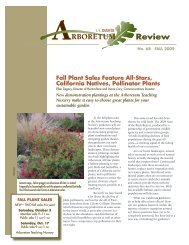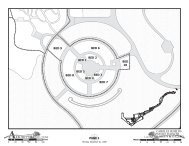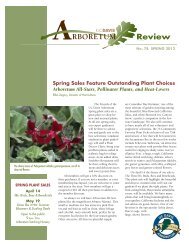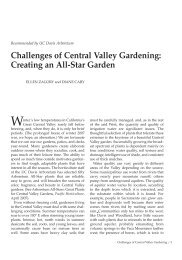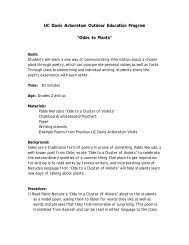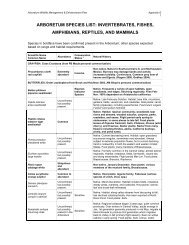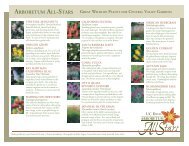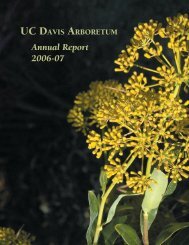F07 Newsletter web.indd - the UC Davis Arboretum
F07 Newsletter web.indd - the UC Davis Arboretum
F07 Newsletter web.indd - the UC Davis Arboretum
Create successful ePaper yourself
Turn your PDF publications into a flip-book with our unique Google optimized e-Paper software.
Emily Griswold<br />
IN THIS ISSUE<br />
Valley-wise gardening ..............1<br />
Storer Garden exhibits .............3<br />
Socolofsky award ....................4<br />
Calendar ..................................5<br />
Garden news ............................6<br />
Donations this quarter ..............7<br />
Directorʼs letter ........................8<br />
Valley-Wise Gardening<br />
by Beth Gale, Nursery Manager<br />
Nursery manager Beth Gale with fl owering Echium wildpretii,<br />
<strong>the</strong> aptly-named tower-of-jewels.<br />
Review<br />
No. 60 FALL 2007<br />
You don’t have to sacrifi ce beauty to be environmentally conscious<br />
The beloved Ruth Risdon Storer Garden is a highlight for many visitors<br />
to <strong>the</strong> <strong>Arboretum</strong>, and rightly so. It is a beautiful example of a Valley-wise<br />
garden. We use <strong>the</strong> term “Valley-wise” to mean gardens with well-adapted<br />
plants, effi cient irrigation, mulch, relatively small areas of turf, porous path<br />
surfaces, and o<strong>the</strong>r features appropriate for California’s Central Valley and<br />
regions with similar conditions.<br />
To create your own Valley-wise garden, choose plants that are drought<br />
tolerant, are pest and disease resistant (which reduces your pesticide and<br />
fungicide use), require low maintenance, and provide food for benefi cial<br />
insects and birds. Make sure you water during cool morning hours, irrigate<br />
<strong>the</strong> whole root zone by watering deeply just every two weeks, and adjust<br />
spray nozzles to avoid watering sidewalks and paths. Use mulch to help<br />
keep weeds down (reducing <strong>the</strong> need to apply herbicides), minimize loss<br />
of moisture from soil, reduce soil compaction, and moderate root zone temperature<br />
(it keeps roots cooler in <strong>the</strong> summer and warmer in <strong>the</strong> winter).<br />
You don’t have to sacrifi ce beauty to be environmentally conscious,<br />
and <strong>the</strong> Storer Garden has proved that with <strong>the</strong> right ingredients you can<br />
enjoy a rewarding and spectacular outcome. Many <strong>Arboretum</strong> All-Star<br />
plants (see “<strong>Arboretum</strong> All-Stars: 50 Great Plants for Central Valley Gardens,”<br />
<strong>Arboretum</strong> Review, Fall 2005) and o<strong>the</strong>r great plants found in <strong>the</strong><br />
Storer Garden will be available at our Fall Plant Faire on October 6. Here<br />
are a few highlights.<br />
Shrubs for background and large spaces<br />
Marie Simon’s pink ceanothus (Ceanothus × pallidus ‘Marie Simon’) has<br />
clouds of pink fl owers in midsummer with semi-deciduous foliage borne<br />
on red stems. Although this isn’t a native ceanothus, it is quite drought<br />
tolerant. It’s a nice change of fl ower color and has larger, attractive leaves.<br />
Faire<br />
Saturday, October 6 Member sale 7-9 a.m., public sale 9 a.m.-3 p.m.<br />
<strong>Arboretum</strong> Nursery at Orchard Park (Orchard Road at LaRue Road, <strong>UC</strong> <strong>Davis</strong>)<br />
Plant<br />
Find great plants<br />
at <strong>the</strong><br />
33rd ANNUAL<br />
10% member discount! Join or renew at <strong>the</strong> door for a free plant!<br />
$5 off membership fee—one day only!
Correa ‘Dusky Bells’ is a charming Australian native that<br />
has large, long dark-pink tubular bell fl owers that cover <strong>the</strong><br />
plant in January. This is a hummingbird favorite and really<br />
cheery in <strong>the</strong> dead of winter. Ribes malvaceum ‘Montara Rose’<br />
is a lovely California native that prefers part shade. It blooms in<br />
mid to late winter before much of <strong>the</strong> garden even looks alive.<br />
The fl owers are an unexpected darker pink that attract hummingbirds<br />
and people alike.<br />
Ribes malvaceum<br />
Charles Webber © California Academy of Sciences<br />
Rose glow Japanese barberry (Berberis thunbergii ‘Rose<br />
Glow’) is a stunning plant with bronze-red new foliage that is<br />
marbled with pinkish-white markings and looks as though an<br />
artist has been at work. This is a versatile shrub that can be<br />
used as a specimen plant or as a hedge and provides red berries<br />
in <strong>the</strong> fall for birds. It requires regular irrigation. Oakleaf<br />
hydrangea (Hydrangea quercifolia) is a handsome shrub for a<br />
shaded area with its oak-like leaves that turn crimson in <strong>the</strong> fall<br />
and large, elongated white fl ower clusters in early summer that<br />
last for months. It requires regular irrigation.<br />
Accent plants with spiky, upright forms<br />
Tower-of-jewels (Echium wildpretii) is an oddball in <strong>the</strong><br />
sense that it is a biennial, meaning it just grows vegetatively<br />
for <strong>the</strong> fi rst year and <strong>the</strong>n blooms and dies <strong>the</strong> second year. It<br />
seems at fi rst that it is an ordinary and unassuming plant, but<br />
by <strong>the</strong> second year you see what it is truly made of. It sends up<br />
a show-stopping six to ten foot column of small rosy red fl owers<br />
that attract bees. Your neighbors will all be asking, “What is<br />
that plant?”<br />
Dusky chief New Zealand fl ax (Phormium ‘Dusky Chief’)<br />
is a New Zealand native that looks much like a grass but is<br />
actually in <strong>the</strong> agave family. This plant has a pleasing upright<br />
structure with rich wine red leaves that glow when backlit.<br />
Many phormiums struggle with our hot summers, but this one<br />
has proven itself worthy in <strong>the</strong> garden.<br />
Great grasses<br />
Purple love grass (Eragrostis spectabilis) is a great small<br />
and manageable grass that has delicate puffs of rosy-purple to<br />
golden fl owers in late summer and foliage turning reddish in<br />
<strong>the</strong> fall. With a common name like love grass, who wouldn’t<br />
want this addition to <strong>the</strong>ir garden? Shenandoah switch grass<br />
(Panicum virgatum ‘Shenandoah’) is one of my personal favorite<br />
grasses. It has blue-green foliage tipped with red and will turn<br />
Ellen Zagory<br />
all maroon in <strong>the</strong> fall. In midsummer it sends up red fl ower clusters<br />
that can last throughout winter. In a breeze it adds wonderful<br />
movement to <strong>the</strong> garden and really glistens in <strong>the</strong> sun.<br />
Large perennials for <strong>the</strong> back of <strong>the</strong> border<br />
Mexican lobelia (Lobelia laxifl ora) has showy tubular redorange<br />
blossoms that persist over <strong>the</strong> long summer season. This<br />
Southwest native doesn’t mind some neglect and attracts hummingbirds<br />
in <strong>the</strong> meantime. Perennial stock (Matthiola incana)<br />
is a short-lived but funky “Dr. Seuss” plant that has very fragrant<br />
fl owers in <strong>the</strong> spring. It may not look like much in <strong>the</strong> fall, but<br />
you’ll be glad you have it in <strong>the</strong> spring.<br />
Mid-sized plants<br />
Autumn joy sedum (Sedum ‘Herbstfreude’) is a great garden<br />
classic with pink fl owers in late summer that change color<br />
throughout fall and succulent leaves that also change to yellow<br />
in <strong>the</strong> fall. The butterfl ies and bees really appreciate <strong>the</strong> food, and<br />
you’ll enjoy <strong>the</strong> lasting beauty it brings as <strong>the</strong> rest of your garden<br />
prepares for winter.<br />
Pewterleaf pelargonium (Pelargonium sidoides) has velvety<br />
gray leaves and rich burgundy fl owers that keep going most of<br />
<strong>the</strong> year and is truly jewel-like. Amy’s purple hebe (Hebe ‘Amy’)<br />
is an evergreen New Zealand native with showy violet fl owers in<br />
summer, but is grown more for its purpled-tinged foliage. This<br />
plant has a nice neat form and is rewarding throughout <strong>the</strong> year.<br />
Mexican honeysuckle (Justicia ( spicigera) is a Mexican native that<br />
provides bright orange fl owers from spring through fall that <strong>the</strong><br />
hummingbirds just love. Its evergreen foliage provides year-round<br />
interest but may look best cut back in early spring.<br />
Low-growing perennials for <strong>the</strong> front of <strong>the</strong><br />
border and for ground cover<br />
Lebanese oregano<br />
(Origanum libanoticum)<br />
is a trailing Mediterranean<br />
native with cute<br />
round leaves and decorative<br />
pink bracts. To<br />
get <strong>the</strong> most effect out<br />
of this plant, put it in a<br />
container or near a wall<br />
edge. Dwarf plumbago<br />
(Ceratostigma plumbaginoides)<br />
is a terrifi c low<br />
growing groundcover<br />
Origanum libanoticum<br />
with brilliant peacock<br />
blue fl owers and<br />
foliage that turns to<br />
maroon in <strong>the</strong> fall. Both Catlin’s giant carpet bugle (Ajuga reptans<br />
‘Catlin’s Giant’), with purple torch-like fl owers in <strong>the</strong> spring, and<br />
Can-can coralbells (Heuchera ‘Can-Can’), with purple foliage year<br />
round, make excellent colorful shade accents.<br />
Using <strong>the</strong> practices described above and <strong>the</strong> cool and<br />
unusual plants from our sale, you will be able to make your own<br />
Valley-wise garden and enjoy it for years to come.<br />
2 <strong>UC</strong> DAVIS ARBORETUM REVIEW
Storer Garden Exhibits Highlight Valley-Wise Gardening<br />
By Holly Crosson, Interpretation Coordinator<br />
Would you like to create a beautiful home garden that<br />
will save you money, give you more free time and enhance <strong>the</strong><br />
environment? Novice and seasoned gardeners alike can learn by<br />
visiting <strong>the</strong> seven<br />
new interpretive<br />
exhibits about Valley-wise<br />
gardening<br />
in <strong>the</strong> Ruth Risdon<br />
Buddy Plants_food_6x9 3/23/07 4:41 PM Page 1<br />
Storer Garden.<br />
PROVIDE FOR<br />
Most California<br />
gardens are<br />
given 40% more<br />
water than <strong>the</strong>y<br />
need. Too much<br />
watering is <strong>the</strong> major<br />
cause of plant<br />
death in many<br />
home gardens. In<br />
one of <strong>the</strong> new<br />
exhibits you’ll<br />
have a chance to<br />
test your watering<br />
wisdom and learn<br />
how to create a<br />
Valley-wise garden,<br />
one that needs<br />
water only once<br />
every two weeks<br />
for about seven<br />
months of <strong>the</strong><br />
year, April through<br />
October.<br />
Wayne Roderick seaside daisy<br />
Erigeron ‘Wayne Roderick’<br />
BENEFICIAL INSECTS<br />
Buddy, or companion, plants like seaside daisy<br />
and goldenrod attract adult beneficial insects,<br />
adding beauty and function to your garden.<br />
California goldenrod<br />
Solidago californica<br />
<strong>UC</strong>DAVIS<br />
RBORETUM<br />
Ruth Risdon Storer Garden–A Valley-Wise Garden<br />
arboretum.ucdavis.edu<br />
Sign made possible by a grant from <strong>the</strong> Elvenia J. Slosson Foundation<br />
We eat aphids!<br />
Syrphid fly adults feed<br />
on <strong>the</strong> nectar and pollen<br />
of companion plants.<br />
Growing <strong>the</strong>se plants in<br />
a location close to roses<br />
encourages beneficial<br />
insects to lay <strong>the</strong>ir eggs<br />
nearby. Larvae <strong>the</strong>n<br />
hatch and can feed on<br />
aphids and o<strong>the</strong>r rose<br />
pest insects.<br />
This exhibit teaches visitors about using companion<br />
plantings to support benefi cial insects for pest control<br />
in Central Valley gardens.<br />
Many gardeners<br />
know that<br />
mulch protects <strong>the</strong> soil, reduces weed growth and water use,<br />
and improves <strong>the</strong> garden’s appearance, but have you ever wondered<br />
how to select <strong>the</strong> right type of mulch, how much to use,<br />
and how often you should reapply it? The new mulch exhibit<br />
focuses on <strong>the</strong> numerous benefi ts of using mulch in your garden<br />
and gives practical advice about how to do it.<br />
Who doesn’t love a rose in <strong>the</strong> garden? This deep affection<br />
may turn to frustration if you have roses that are susceptible to<br />
common fungal problems like powdery mildew, black spot and<br />
rust. These diseases don’t have to ruin your roses if you choose<br />
resistant varieties such as those highlighted in our new exhibit<br />
about low-maintenance roses. Insect pests such as aphids can<br />
also plague roses. With careful companion planting near your<br />
roses (using “buddy” plants like deergrass and yarrow), you<br />
can attract and shelter benefi cial insects that will eat aphids and<br />
solve your problem without <strong>the</strong> use of pesticides.<br />
Melissa Borel<br />
Melissa Borel<br />
<strong>UC</strong> IPM<br />
In addition to <strong>the</strong> new Valley-wise gardening exhibit at<br />
<strong>the</strong> Storer Garden, look for new orientation signs that introduce<br />
visitors to <strong>the</strong> history and importance of our plant<br />
collections, along with new wayfi nding signs that help<br />
visitors locate important features, in <strong>the</strong> Carolee Shields<br />
White Flower Garden and Gazebo, <strong>the</strong> Eric E. Conn Acacia<br />
Grove, <strong>the</strong> Warren G. Roberts Redbud Collection, <strong>the</strong> Australian<br />
Collection, and <strong>the</strong> East Asian Collection.<br />
The new exhibits are made possible by grants from <strong>the</strong><br />
Elvenia J. Slosson Foundation, <strong>the</strong> Institute for Museum<br />
and Library Services, and <strong>the</strong> <strong>UC</strong> <strong>Davis</strong> Offi ce of Administration<br />
Campus Sustainability Program.<br />
Australian_Wayfind 4/10/07 2:51 PM Page 1<br />
Australian<br />
Collection<br />
<strong>UC</strong>DAVIS<br />
RBORETUM<br />
Sign made possible by a grant from <strong>the</strong> Institute of Museum and Library Services<br />
BENCHES IN STORER GARDEN<br />
AVAILABLE FOR DEDICATION<br />
Are you looking for a way to thank an important<br />
person in your life or honor <strong>the</strong> memory of<br />
a loved one? Consider dedicating a bench in <strong>the</strong><br />
<strong>Arboretum</strong> in <strong>the</strong>ir honor. Three of <strong>the</strong> lovely new<br />
benches in <strong>the</strong> Storer Garden are still available to be<br />
dedicated. Your contribution will ensure <strong>the</strong> continued<br />
maintenance and improvement of this beautiful<br />
garden, and your honoree will be recognized with a<br />
handsome plaque on <strong>the</strong> bench.<br />
To learn more about <strong>the</strong> <strong>Arboretum</strong> commemoration<br />
program, please contact Amy McGuire at<br />
(530) 754-9126 or almcguire@ucdavis.edu.<br />
FALL 2007 3<br />
Betsy Faber<br />
Wayfi nding signs<br />
like this one for <strong>the</strong><br />
Australian Collection<br />
help visitors navigate<br />
through <strong>the</strong> gardens.
National Recognition for <strong>Arboretum</strong> Director<br />
by Mary Burke, Director of Planning and Collections<br />
Kathleen Socolofsky Receives <strong>the</strong> American Public Gardens Association 2007 Professional Citation Award<br />
<strong>Arboretum</strong> Director Kathleen Socolofsky (second from left) received <strong>the</strong> 2007 Professional<br />
Citation Award of <strong>the</strong> American Public Gardens Association in Washington, D.C. in June. This<br />
national award honors a public garden professional for signifi cant achievements in public<br />
horticulture. Pictured presenting Kathleen with a plaque are awards committee members<br />
(l. to r.) Eric Tschanz, President and Executive Director, Powell Gardens; Virginia Hayes,<br />
Curator, Ganna Walska Lotusland; and Dan Stark, Executive Director, APGA.<br />
In Washington, D.C., at <strong>the</strong> annual meeting of <strong>the</strong> American<br />
Public Gardens Association (APGA), conference attendees stood and<br />
applauded loudly as <strong>the</strong> <strong>UC</strong> <strong>Davis</strong> <strong>Arboretum</strong> Director, Kathleen<br />
Socolofsky, received <strong>the</strong> 2007 APGA Professional Citation Award. One<br />
of <strong>the</strong> highest awards in our fi eld, <strong>the</strong> APGA Professional Citation<br />
recognizes <strong>the</strong> signifi cant accomplishments in public horticulture of<br />
a mid-career professional who has excelled in one of <strong>the</strong> disciplines<br />
generally associated with public gardens and who has shown great<br />
skill, innovation, and achievement in his or her career. Kathleen was<br />
<strong>the</strong> unanimous choice of <strong>the</strong> national APGA Awards Committee.<br />
The APGA National Award Committee awarded this Professional<br />
Citation in acknowledgement of Kathleen’s demonstrated mastery<br />
of strategic thinking, leadership, and management at <strong>the</strong> <strong>UC</strong> <strong>Davis</strong><br />
<strong>Arboretum</strong> and for her successful launch of multiple new initiatives<br />
here at <strong>UC</strong> <strong>Davis</strong>, as well as for <strong>the</strong> ground-breaking work in innovative<br />
methods of exhibit development for informal science museums<br />
she developed at <strong>the</strong> Desert Botanical Garden. We are all very proud to<br />
be working with her.<br />
During <strong>the</strong> past several years, Kathleen led several major new<br />
campus initiatives, with <strong>the</strong> <strong>UC</strong> <strong>Davis</strong> <strong>Arboretum</strong> at <strong>the</strong> center:<br />
• Kathleen led <strong>the</strong> <strong>Arboretum</strong> through a community-centered planning<br />
process that incorporated over 4,000 visitor surveys and<br />
resulted in a comprehensive ten-year plan. This effort, involving<br />
campus and political leaders, excited new interest and ideas about<br />
<strong>the</strong> possible role <strong>the</strong> <strong>UC</strong> <strong>Davis</strong> <strong>Arboretum</strong> could play on campus.<br />
• Working with business leaders in <strong>the</strong> California<br />
nursery industry and with deans and faculty at<br />
<strong>UC</strong> <strong>Davis</strong>, Kathleen helped lead <strong>the</strong> launch of <strong>the</strong><br />
new California Center for Urban Horticulture. The<br />
<strong>UC</strong> <strong>Davis</strong> College of Agriculture and Environmental<br />
Sciences (CA&ES) recently committed more than<br />
$1 million dollars over fi ve years for this major new<br />
campus initiative.<br />
• Under Kathleen’s leadership, <strong>the</strong> <strong>Arboretum</strong><br />
began <strong>the</strong> popular <strong>Arboretum</strong> All-Stars program, a<br />
program promoting <strong>the</strong> best garden plants for <strong>the</strong><br />
Central Valley of California. This innovative project<br />
has attracted national attention.<br />
• Working with faculty in <strong>the</strong> School of Education<br />
and CA&ES, Kathleen initiated <strong>the</strong> <strong>UC</strong> <strong>Davis</strong><br />
GATEways Program (Gardens, Art, and <strong>the</strong> Environment).<br />
This new campus initiative proposes a<br />
new model for a contemporary land-grant university—one<br />
that puts <strong>UC</strong> <strong>Davis</strong> students front and<br />
center, leading tours, teaching classes, and explaining<br />
<strong>the</strong> work of <strong>UC</strong> <strong>Davis</strong> researchers and scholars<br />
to <strong>Arboretum</strong> visitors.<br />
• Working with <strong>the</strong> CA&ES Dean of Undergraduate<br />
Education and local artists, Kathleen also helped<br />
expand <strong>the</strong> Art/Science Fusion Program, using <strong>the</strong><br />
experience of art as a way to teach science.<br />
O<strong>the</strong>r <strong>UC</strong> <strong>Davis</strong> <strong>Arboretum</strong> staff also made an<br />
impact at this year’s national conference. Carmia Feldman<br />
presented a well-received talk on <strong>the</strong> <strong>Arboretum</strong>’s<br />
exhibit development program. Emily Griswold led <strong>the</strong><br />
fi rst meeting of a national oak curatorial group and<br />
Mary Burke presented <strong>the</strong> new national zoo-botanical<br />
garden GIS initiative to APGA information technology<br />
specialists, recruiting members for <strong>the</strong> new Alliance for<br />
Public Garden GIS. Missy Borel and Brian Morgan, <strong>UC</strong><br />
<strong>Davis</strong> graduate students and <strong>Arboretum</strong> employees, each<br />
received a student travel award from APGA that allowed<br />
<strong>the</strong>m to attend <strong>the</strong> meeting and meet professional botanical<br />
garden staff from around <strong>the</strong> country.<br />
ARBORETUM ON PUBLIC T.V.<br />
The <strong>Arboretum</strong> was featured in an episode of Road<br />
Trip with Huell Howser, which aired July 12 on public<br />
television stations statewide. The popular host interviewed<br />
director of horticulture Ellen Zagory and commented,<br />
“I’ve never visited a park as beautiful as <strong>the</strong><br />
[<strong>UC</strong> <strong>Davis</strong>] <strong>Arboretum</strong>. It’s unbelieveable... That’s as<br />
beautiful a place as anywhere I’ve been in California.”<br />
4 <strong>UC</strong> DAVIS ARBORETUM REVIEW
CALENDAR OF EVENTS<br />
FALL 2007<br />
GUIDED TOURS<br />
No charge, no reservation required<br />
PLANT FAIRE PREVIEW TOUR<br />
Saturday, September 29, 11: 00 a.m.<br />
Orchard Park Nursery<br />
WALK WITH WARREN<br />
Wednesday, October 10, 12:00 p.m., Gazebo<br />
PLANNING YOUR GARDEN TO CONSERVE WATER<br />
Sunday, October 14, 2:00 p.m., Gazebo<br />
FALL IN THE NATIVE PLANT GARDEN<br />
Saturday, October 20, 11:00 a.m.<br />
Buehler Alumni & Visitors Center<br />
GARDENING WITH THE LOCAL ENVIRONMENT<br />
Saturday, October 27, 11:00 a.m., Gazebo<br />
UP CLOSE AND PERSONAL WITH CALIFORNIA<br />
NATIVE TREES<br />
Saturday, November 3, 11:00 a.m.<br />
Buehler Alumni & Visitors Center<br />
CHANGING SEASONS IN THE ARBORETUM<br />
Saturday, November 10, 11:00 a.m.<br />
Buehler Alumni & Visitors Center<br />
WALK WITH WARREN<br />
Wednesday, November 14, 12:00 p.m.<br />
<strong>Arboretum</strong> Headquarters<br />
VALLEY GARDENING THE RIGHT WAY<br />
Saturday, November 17, 11:00 a.m.<br />
<strong>Arboretum</strong> Terrace Garden<br />
IMPROVE YOUR CONTAINER GARDENING<br />
Saturday, December 1, 11:00 a.m.<br />
<strong>Arboretum</strong> Terrace Garden<br />
BUTTERFLIES IN AND AROUND<br />
THE ARBORETUM<br />
Saturday, September 29, 1:00-3:00 p.m., Wyatt Deck<br />
Join Entomology Professor Arthur Shapiro for an informal talk on our local<br />
butterfl ies, followed by a walk through <strong>the</strong> Mary Wattis Brown Garden of California<br />
Narive Plants to look for butterfl ies and <strong>the</strong>ir habitats. All ages welcome!<br />
PRACTICING NATIVE CULTURE<br />
Sunday, October 14, 1:00-3:00 p.m., Wyatt Deck<br />
Join Maidu/Wintun/Hupa/Yurok cultural interpreter Diana Almendariz as she<br />
shares traditional plant knowledge through stories and hands-on activities. Learn to<br />
make a doll from tule reeds, and try your hand at grinding acorns. All ages welcome!<br />
BOTANICAL WATERCOLOR WORKSHOP:<br />
POMEGRANATES<br />
Saturday-Sunday, October 20-21, 2007<br />
9:00 a.m. – 4:00 p.m., <strong>Arboretum</strong> Headquarters Library<br />
Fees: $120 ($100 members, students) + $15 materials fee (required)<br />
Two-day workshop for students at any level. Beginners welcome. All students<br />
will create <strong>the</strong>ir own botanical watercolors of pomegranates. Paints, paper, and tools<br />
provided by instructor Ca<strong>the</strong>rine Buscaglia. Advance registration required: (530) 752-<br />
4880, jhayes@ucdavis.edu.<br />
FOLK MUSIC JAM SESSIONS<br />
Alternate Fridays, October 5, 19, November 2, 16, 30, December 14<br />
(no session Dec. 28)<br />
12:00 p.m., Wyatt Deck (next to Redwood Grove)<br />
Pull out your fi ddles, guitars, mandolins, banjos (you name it) for an acoustic<br />
jam session. Campus and community folk musicians play toge<strong>the</strong>r over <strong>the</strong> lunch<br />
hour. All skill levels welcome. Listeners welcome!<br />
ARBORETUM VOLUNTEER TRAINING<br />
Tuesdays, Oct. 16–Dec. 4 (no class Nov. 20), 9:00 a.m.–12:00 p.m.<br />
Fee: $55/$45 members<br />
Learn about Central Valley gardening and California natural history. Train to<br />
become a volunteer gardener, nursery assistant, docent, or naturalist. No experience<br />
necessary. Contact Amy McGuire at (530) 754-9126 or almcguire@ucdavis.edu.<br />
WALK WITH WARREN<br />
Wednesday, December 12, 12:00 p.m., Gazebo<br />
Plant Faire<br />
33rd ANNUAL<br />
Saturday, October 6 Member sale 7-9 a.m., public sale 9 a.m.-3 p.m.<br />
<strong>Arboretum</strong> Nursery at Orchard Park (Orchard Road at LaRue Road, <strong>UC</strong> <strong>Davis</strong>)<br />
10% member discount—Join or renew at <strong>the</strong> door for a free plant—$5 off membership—one day only!<br />
Don’t miss <strong>the</strong> biggest and best plant sale in <strong>the</strong> Central Valley! More than 1,000 varieties of great plants for your garden.<br />
Featuring <strong>Arboretum</strong> All-Star plants and a great selection of native plants. Locally grown, adapted to our climate.<br />
Fabulous houseplants and exotics from <strong>the</strong> Botanical Conservatory. Expert gardeners will be available to advise you.<br />
Proceeds support <strong>the</strong> <strong>Arboretum</strong> and <strong>the</strong> Conservatory. See plant list at arboretum.ucdavis.edu in mid-September.<br />
FALL 2007 5
Garden News<br />
VOLUNTEER TRAINING<br />
Would you like to learn more about California ecology and Central Valley<br />
gardening, join a group of active, dedicated people, and make a real contribution<br />
to <strong>the</strong> important work of <strong>the</strong> <strong>Arboretum</strong>? You are invited to become an <strong>Arboretum</strong><br />
volunteer. There is something for everyone in <strong>the</strong> <strong>Arboretum</strong>’s volunteer program.<br />
This year we are recruiting for tour leaders for adults and school groups,<br />
volunteer gardeners, and nursery assistants.<br />
This year’s volunteer training course will meet on Tuesday mornings, 9:00<br />
a.m. to noon, October 16–December 4 (no class November 20). Following <strong>the</strong><br />
core course, <strong>the</strong>re will be additional training in each of <strong>the</strong> areas of specialization.<br />
The fee for <strong>the</strong> course is $55, or $45 for members of <strong>the</strong> Friends of <strong>the</strong> <strong>UC</strong> <strong>Davis</strong><br />
<strong>Arboretum</strong>. To learn more about volunteering or to sign up for <strong>the</strong> course, please<br />
contact Amy McGuire at (530) 754-9126 or almcguire@ucdavis.edu.<br />
NATURE’S GALLERY<br />
This spectacular ceramic mosaic mural, created<br />
by <strong>UC</strong> <strong>Davis</strong> students, community members<br />
and <strong>Arboretum</strong> staff and volunteers, was <strong>the</strong> talk<br />
of <strong>the</strong> town in Washington, D.C. this summer. It<br />
was installed in <strong>the</strong> U.S. Botanic Garden on <strong>the</strong><br />
Capitol Mall as part of an exhibit created by <strong>the</strong><br />
American Public Gardens Association (APGA) to<br />
celebrate <strong>the</strong> important work done by America’s<br />
public gardens. Twenty gardens from across<br />
<strong>the</strong> country were showcased in this exhibit.<br />
The mural depicts drought-tolerant plants in<br />
<strong>the</strong> Ruth Risdon Storer Garden at <strong>the</strong> <strong>UC</strong> <strong>Davis</strong><br />
<strong>Arboretum</strong> and <strong>the</strong>ir insect associates, and<br />
demonstrates an innovative model for educating<br />
students and <strong>the</strong> public about <strong>the</strong> sciences<br />
through <strong>the</strong> arts. The mural was a GATEways<br />
pilot project by <strong>the</strong> Art/Science Fusion Program, under <strong>the</strong> leadership of Professor<br />
of Entomology and CA&ES Associate Dean for Undergraduate Education<br />
Diane Ullman and ceramic artist Donna Billick, with support from <strong>the</strong> Provost’s<br />
Offi ce and <strong>the</strong> College of Agricultural and Environmental Sciences. The mural<br />
will be in Washington until October, when it will return to <strong>Davis</strong> to be permanently<br />
installed in <strong>the</strong> <strong>Arboretum</strong>.<br />
RYAN DEERING REJOINS<br />
HORTICULTURE STAFF<br />
By Emily Griswold, Asst. Dir. of Horticulture<br />
Please join us in welcoming Ryan<br />
Deering back to <strong>the</strong> <strong>Arboretum</strong> staff as our<br />
new GATEways Horticulturist. As Nursery<br />
Manager from 2000 to 2005 Ryan transformed<br />
Orchard<br />
Park Nursery<br />
into a new plant<br />
sales venue and<br />
greatly expanded<br />
<strong>the</strong> nursery<br />
volunteer and<br />
internship<br />
programs. Ryan<br />
left <strong>the</strong> <strong>Arboretum</strong><br />
in spring of<br />
2005 to travel<br />
<strong>the</strong> world with<br />
his wife, Annie. Their 15-month journey included<br />
stops in France, Switzerland, Turkey,<br />
Botswana, South Africa, India, Myanmar,<br />
Thailand, and Australia.<br />
Two highlights of Ryan’s travels were<br />
garden internships in <strong>the</strong> Mediterranean<br />
climate regions of South Africa and Western<br />
Australia. He had <strong>the</strong> opportunity to spend<br />
two months as an intern at <strong>the</strong> Kirstenbosch<br />
National Botanical Garden in Cape Town.<br />
Kirstenbosch is dedicated to <strong>the</strong> native plants<br />
of <strong>the</strong> Cape Province, so it was a perfect setting<br />
to study <strong>the</strong> incredible biodiversity of<br />
<strong>the</strong> local fl ora. During Ryan’s month-long<br />
internship at <strong>the</strong> King’s Park Botanic Garden<br />
in Perth, Australia he participated in an ecological<br />
restoration project and a fi re ecology<br />
study in <strong>the</strong> garden’s on-site nature preserve.<br />
One of his most memorable experiences was<br />
scuba diving to monitor stands of seagrass in<br />
shark-infested waters!<br />
Now that he’s back home, Ryan’s newest<br />
adventure is to learn about fa<strong>the</strong>rhood.<br />
He and Annie had a daughter, Zara Jane<br />
Deering, on May 23. Ryan’s new challenge as<br />
GATEways Horticulturist at <strong>the</strong> <strong>Arboretum</strong><br />
will be to work with volunteers, students,<br />
and academic partners on new garden<br />
development and renovation projects. He’s<br />
brimming with new ideas for interpretation<br />
and outreach in <strong>the</strong> <strong>Arboretum</strong>, which are<br />
key elements of <strong>the</strong> GATEways project. Ryan’s<br />
current projects include completing <strong>the</strong><br />
renovation of <strong>the</strong> Acacia Grove, developing<br />
plans for new plantings in <strong>the</strong> Australian<br />
Collection, and creating and leading a new<br />
native plant horticulture internship program.<br />
6 <strong>UC</strong> DAVIS ARBORETUM REVIEW<br />
Walter Sistrunk Marion Socolofsky<br />
Linda Johnson
Donations this Quarter<br />
We extend our sincere gratitude to <strong>the</strong>se donors<br />
NEW & RENEWING MEMBERS<br />
Gerri Adler<br />
Kirk Alexander<br />
Thomas & Patricia Allen<br />
Ca<strong>the</strong>rine Anderson<br />
Peggy Bakarich<br />
Bernadette Balics<br />
Cidney Barcellos<br />
Glenn Bartley<br />
Brooke Baythavong<br />
Gary Beall<br />
James Richard Blackmarr<br />
Jacklyn Boettner<br />
Joanne Bowen<br />
Gillian A. Brady-Pagel<br />
Dorothy Brandon<br />
Paul & Dianna Brink<br />
Evelyn Brown<br />
Jon Ramsey &<br />
Melissa Browne<br />
Elizabeth Capell<br />
Gloria Carboni<br />
Irina Chakraborty<br />
Roger Chetelat<br />
Anita Clevenger<br />
Lynn & Phil Conner<br />
Jennine Cornelius<br />
Ann Costello<br />
Ramona Lee Cramer<br />
Dr. & Mrs. Gerald Cresci<br />
Sarah D’Souza<br />
Richard & Judy Dowell<br />
Carolyn Doyle<br />
Steve Drown<br />
Mickey Elkus<br />
Jodee Ellett<br />
JOIN <strong>the</strong> Friends of <strong>the</strong> <strong>UC</strong> <strong>Davis</strong> <strong>Arboretum</strong><br />
Name<br />
Address<br />
Phone<br />
E-mail<br />
Candace Embrey<br />
JoAnn English<br />
Hazel & Emanuel Epstein<br />
Cheryl Essex<br />
Kim Everist<br />
Lori Lubin and Chris<br />
Fassnacht<br />
Dennis Ferguson<br />
Alan Hastings &<br />
Elaine Fingerett<br />
Katie Flaherty<br />
Judy Fletcher<br />
Ken Foster<br />
Lisa K. Giambastiani<br />
Neal & Retta Gilbert<br />
Shirley Gold<br />
Dee Goldberg<br />
Nina Gordon<br />
Gwen M. Haagensen<br />
Myrtis Hadden<br />
Sue Haffner<br />
Marlene Hansche<br />
Lori & John Hansen<br />
James Harding<br />
Brian Mulloney &<br />
Ann Hedrick<br />
Carol Hillhouse<br />
Susan Hishio<br />
Neil Willits &<br />
Carole Hom<br />
Patrick Hunt & Suzie<br />
Chock Hunt<br />
Maureen Ivy<br />
Ann Johnson<br />
Maggie Jones<br />
Christine Joshel<br />
Rick & Mikaela Karban<br />
Winston & Katy Ko<br />
Monika Kraft<br />
Manfred Kusch<br />
Brian Larimore<br />
Joann L. Larkey<br />
Lynette Hunter &<br />
Peter Lichtenfels<br />
James & Marjorie<br />
Litsinger<br />
Ron Lutsko, Jr.<br />
Angela Malloy<br />
Jan & Ray Manzi<br />
Bob Markson<br />
Cate McGuire<br />
Kathleen Middings<br />
Sam Moeller<br />
Mary P. Morris<br />
Joan M. Moses<br />
Pam Moyer<br />
Marjorie Muck<br />
Susan & Bruce Muramoto<br />
Jennifer Muramoto<br />
Donna Murrill<br />
Myrna Mussetter<br />
Deanna Myhre<br />
Kathie J. Ngo<br />
Susan Nishro<br />
Steve & Emily Ohrwall<br />
Loren Oki<br />
Robert & Carolyn Padgett<br />
Sue Palmer<br />
Dan & Linda Parfi tt<br />
Les & Lois Partridge<br />
Rose Pearl<br />
David Pellett<br />
Linda S. Pittman<br />
Rosalia Ramos<br />
Helmut & Cheryl Redlich<br />
Jean Risley<br />
Sharon Lynch &<br />
John Roncoroni<br />
Joan Y. Rosenwald<br />
Anna-Liisa Safari<br />
Marian F. Salm<br />
Cynthia Sarver<br />
Julie Saylor<br />
Connie Seaton<br />
Beatrice Seed<br />
Dave Showers<br />
Karen Slinkard<br />
Rena Smilkstein<br />
Robert Snider<br />
Roberta Stevenson<br />
Mary & Christopher<br />
Stokes<br />
Kalynda Stone<br />
Marilyn Stratton<br />
<strong>Davis</strong> Studer<br />
Dawn Sumner<br />
Nancy Sweet<br />
<strong>Davis</strong> Tai<br />
Keith Taylor<br />
Loren Testa<br />
Hon. Mike Thompson<br />
Phil Kitchen—<br />
Three Palms Nursery<br />
Elise Tidrick<br />
Carolyn L. Unruh<br />
Teresa Wai-Man Yeung<br />
H.Y. Wang<br />
Pris Ward<br />
Doug Waterman<br />
Marilyn Watson<br />
Karen Weigt<br />
Barbara Weller<br />
® Check enclosed ® Charge my credit card:<br />
® VISA ® MasterCard ® AmEx Card no. ____________________________________________<br />
MEMBERSHIP CATEGORY<br />
(please check one)<br />
® $15 Student (with ID)<br />
® $40 Individual<br />
® $60 Family / Household<br />
® $100 Manzanita Circle<br />
® $250 Valley Oak Circle<br />
® $500 Sequoia Circle<br />
Signature: _________________________________________ Expiration: ____________ CEV no. __________<br />
(last 3 digits on back of card)<br />
Please make check payable to Friends of <strong>the</strong> <strong>UC</strong> <strong>Davis</strong> <strong>Arboretum</strong> and send to:<br />
Memberships, <strong>UC</strong> <strong>Davis</strong> <strong>Arboretum</strong>, One Shields Ave., <strong>Davis</strong>, CA 95616<br />
Charlotte Cardey &<br />
Juliana Wells<br />
Shawn & Amber Welsh<br />
Cathy White<br />
Valerie Whitworth<br />
Carlye Wilder<br />
Lyle Wilen<br />
Debbie Williams<br />
Diane Wilson<br />
Siv Winberg<br />
MANZANITA CIRCLE<br />
Paul & Christine Buckmaster<br />
Elizabeth Cunningham<br />
Cathie & John Duniway<br />
Suzanne & Bob Hansen<br />
Lorena Herrig<br />
Laurie & Bill Hildebrandt<br />
Leonard Jankowski<br />
David B. Kelley<br />
Doris Ruud<br />
Julia D. Sadler<br />
Bette & Howard Swarts<br />
John & Nan Yates<br />
SEQUOIA CIRCLE<br />
Jay & Terry <strong>Davis</strong>on<br />
Dick & Nancy Quinn<br />
UNRESTRICTED GIFTS<br />
Diana Jahns<br />
Friends of <strong>the</strong> <strong>UC</strong> <strong>Davis</strong><br />
<strong>Arboretum</strong><br />
IN SUPPORT OF THE<br />
LOUISE AND ERIC CONN<br />
ENDOWMENT AND THE<br />
CONN ACACIA GROVE<br />
Eric Conn<br />
IN MEMORY OF MARIAN<br />
FULTON DAGGETT<br />
Barbara Domenik<br />
Stephen & Christine Domenik<br />
Gary & Janet Thatcher<br />
FALL 2007 7
FROM THE DIRECTOR<br />
Dear Friends,<br />
I’d like to use my column this time to thank all of you for supporting <strong>the</strong> <strong>Arboretum</strong>. Support from<br />
individuals is becoming increasingly important as we grow, serve more visitors, and have higher levels of<br />
gardens, exhibits, and programs to maintain.<br />
We are grateful for a major gift from <strong>the</strong> estate of Mary Baer. Planned gifts such as this are critical<br />
to our success because <strong>the</strong>y allow us to make strategic investments in our program and garden development. The Friends of <strong>the</strong><br />
<strong>UC</strong> <strong>Davis</strong> <strong>Arboretum</strong> Board will be working with me this year to educate our members and volunteers about <strong>the</strong> importance of <strong>the</strong>se<br />
types of gifts and to make it easier to plan for <strong>the</strong>m.<br />
I would like to recognize Dr. Eric Conn for his generous gift of $30,000 to be split between long-term use (<strong>the</strong> Louise and Eric<br />
Conn Endowment) and short-term use (improvements to <strong>the</strong> Conn Acacia Grove). This thoughtful gift recognizes <strong>the</strong> importance<br />
of balancing long- and short-term needs in planning for <strong>the</strong> future of <strong>the</strong> <strong>Arboretum</strong>.<br />
I would also like to thank Janet Thatcher and family, Bruce and Bev Watros, and <strong>the</strong> Mel Gagnon family, who have recently<br />
made commemorative contributions to dedicate new benches in <strong>the</strong> Storer Garden. If you would like to honor someone important<br />
to you, <strong>the</strong>re are still three memorial benches in Storer Garden available for dedication (see p.3).<br />
We depend not only on those who make fi nancial contributions, but also on our supporters who contribute <strong>the</strong>ir service. I<br />
would like to thank <strong>the</strong> members of <strong>the</strong> Friends Board who are continuing in <strong>the</strong>ir leadership roles, and welcome Kathy Olson,<br />
who is joining <strong>the</strong> Board as a member at large. Kathy has been an active<br />
nursery volunteer and is taking on <strong>the</strong> leadership of <strong>the</strong> Plant Sales Task<br />
FRIENDS OF THE <strong>UC</strong> DAVIS ARBORETUM<br />
EXECUTIVE BOARD<br />
Mary Patterson, President<br />
Martha Ozonoff, Vice President<br />
Lois Crowe, Secretary<br />
Shirley Maus, Treasurer<br />
Ernie Lewis, Member-at-Large<br />
Kathy Olson, Member-at-Large<br />
ARBORETUM STAFF<br />
Kathleen Socolofsky, Director<br />
Robert Bohn, <strong>Arboretum</strong> Steward<br />
Mary Burke, Director of Planning and Collections<br />
Diane Cary, Communications Director<br />
Holly Crosson, Interpretation Coordinator<br />
Ryan Deering, GATEways Horticulturist<br />
Betsy Faber, Education Outreach Manager<br />
Carmia Feldman, Assistant Director<br />
Elaine Fingerett, Youth and Family Outreach Coordinator<br />
Beth Gale, Nursery Manager<br />
Mary Gibson, Gardening Specialist<br />
Theresa Goman, Gardening Specialist<br />
Emily Griswold, Assistant Director of Horticulture<br />
Judy Hayes, Special Projects Assistant<br />
Mia Ingolia, Curator<br />
Linda Johnson, Administrative Manager<br />
Sabrina Johnston, Business Assistant<br />
Libby McGill, Gardening Specialist<br />
Amy McGuire, Resource Development Manager<br />
Brian Morgan, GIS Project Manager<br />
Warren Roberts, Superintendent<br />
Pat Stoffel, Gardening Specialist<br />
Ellen Zagory, Director of Horticulture<br />
STUDENT STAFF<br />
Rebecca Bain<br />
Nick Burke<br />
Joe Burns<br />
Kim Chacon<br />
Lisa Chaffee<br />
Francesca Claverie<br />
Matt Cool<br />
Elizabeth Frost<br />
Ruth Gebreyesus<br />
Erik Gellerman<br />
Kathryn Gross<br />
Jay Grover<br />
Mana Hattori<br />
Forrest Luna<br />
Susan Magnoli<br />
CA&ES liaison: Allison Chilcott, Major Gifts Offi cer<br />
<strong>Newsletter</strong> Editor/Designer: Diane Cary<br />
Mark Miller<br />
Benjamin Nelson<br />
Remy Pieron<br />
Tracy Rosenthal<br />
Mary Rowan<br />
Navneet Singh<br />
Jordan Thompson<br />
Force.<br />
In fact, I’d like to thank all of our wonderful volunteers, without<br />
whom <strong>the</strong> <strong>Arboretum</strong> would be … well, it’s impossible to imagine <strong>the</strong><br />
<strong>Arboretum</strong> without our volunteers! If you’d like to learn more about<br />
gardening and California ecology, and meet a wonderful group of people,<br />
I invite you to sign up for our annual volunteer training class (see p. 5).<br />
I’m looking forward to seeing you all at <strong>the</strong> 33 rd annual Plant Faire<br />
on Saturday, October 6. Please spread <strong>the</strong> word and invite your friends<br />
and neighbors—this is our most important fundraiser and a great time<br />
for people to join and become supporters of <strong>the</strong> <strong>Arboretum</strong>!<br />
<strong>UC</strong> DAVIS ARBORETUM Review<br />
University of California (AM39)<br />
One Shields Avenue<br />
<strong>Davis</strong>, CA 95616<br />
(530) 752-4880<br />
arboretum.ucdavis.edu<br />
Address service requested<br />
Best regards,<br />
Non-profi t Org.<br />
U.S. Postage<br />
PAID<br />
<strong>Davis</strong>, CA 95616<br />
Permit No. 3





